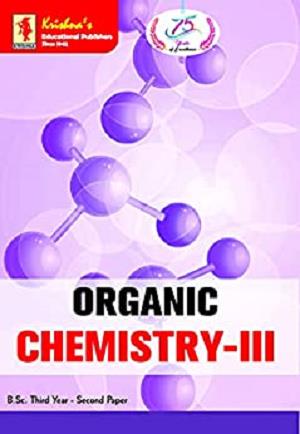
English | 2021 | ASIN: B09656Z48K | 410 pages | PDF | 4.45 MB
SYLLABUS- ORGANIC CHEMISTRY-III,
UNIT-I
I. Spectroscopy: Nuclear magnetic resonance (NMR) spectroscopy, Proton magnetic
resonance (1H NMR) spectroscopy, nuclear shielding and deshielding, chemical shift and
molecular structure, spin-spin splitting and coupling constants, areas of signals, interpretation
of 1H NMR spectra of simple organic molecules such as ethyl bromide, ethanol, acetaldehyde,
1, 1, 2-tribromoethane, ethyl acetate, toluene and acetophenone, Problems pertaining to the
structures elucidation of simple organic compounds using UV, IR and 1H NMR spectroscopic,
techniques.
UNIT-II
II. Organometallic Compounds: Organomagnesium compounds: the Grignard reagents,
formation, structure and chemical reactions. Organozinc compounds: formation and chemical
reactions. Organolithium compounds: formation and chemical reactions.
III. Organosulphur Compounds: Nomenclature, structural formation, methods of
formation and chemical reactions of thiols, thioethers, sulphonic acids, sulphonamides and
Sulphaguanidine.
IV. Hetrocyclic Compounds: Introduction: Molecular orbital picture and aromatic
characteristics of pyrrole, furan, thiophene and pyridine, Methods of synthesis and chemical
reactions with particular emphasis on the mechanism of electrophilic substitution,
Mechanism of nucleophilic substitution reaction in pyridine derivatives, Comparison of
basicity of pyridine, piperidine and pyrrole. Introduction to condensed five and six membered heterocycles, Preparation and reactions of indole, quinoline and isoquinoline with special
reference to Fisher indole synthesis, Skraup synthesis and Bischler-Nepieralski synthesis,
Mechanism of electrophilc substitution reactions of indole, quinoline and isoquinoline.
UNIT-III
V. Carbohydrates: Classification and nomenclature, Monosaccharides, mechanism of
osazone formation, interconversion of glucose and fructose, chain lengthening and chain
shortening of aldoses. Configuration of monosaccharides, Erythro and threo diastereomers,
Conversion of glucose intro mannose, Formation of glcosides, ethers and esters,
Determination of ring size of monosaccharides, Cyclic structure of D(+)-glucose, Mechanism
of mutarotation. Structures of ribose and deoxyribose, An introduction to disaccharides
(maltose, sucrose and lactose) and polysaccharides (starch and cellulose) without involving
structure determination.
VI. Amino Acids, Peptides, Proteins and Nucleic Acids: Classification, structure and
stereochemistry of amino acids, Acid-base behaviour isoelectric point and electrophoresis,
Preparation and reactions of -amino acids, Structure and nomenclature of peptides and
proteins, Classification of proteins, peptide structure determination, end group analysis,
selective hydrolysis of peptides, classical peptide synthesis, solid-phase peptide synthesis,
Structures of peptides and proteins, Levels of protein structure, Protein denaturation/
renaturation; Nucleic acids : Introduction, constituents of nucleic acids, Ribonucleosides and
ribonucleotides, The double helical structure of DNA.
download скачать
https://nitroflare.com/view/C7CF857C9659FCC/dmwca.Krishnas..Organic.ChemistryIII.Edition5B.pdf
https://rapidgator.net/file/f7daa595c409825a5f5da833f7a735c4/dmwca.Krishnas..Organic.ChemistryIII.Edition5B.pdf

